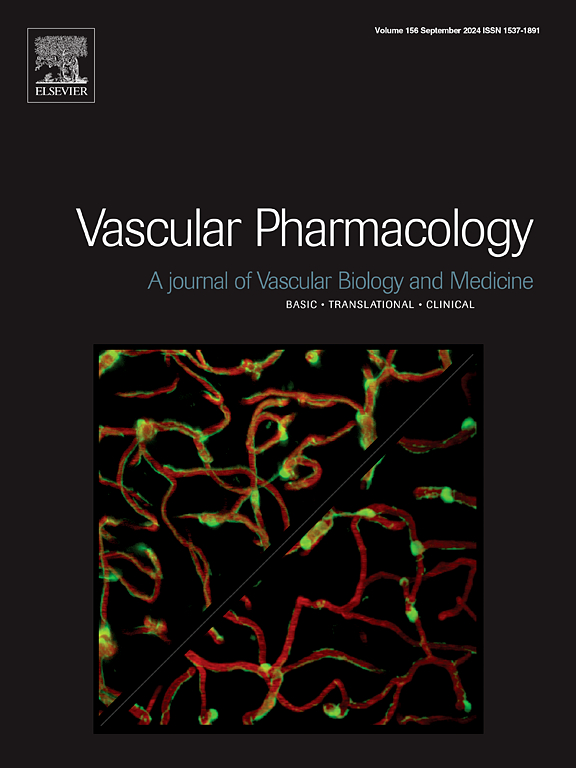Clinical outcomes and safety of sotatercept in pulmonary arterial hypertension: A systematic review and meta-analysis of randomized controlled trials
IF 3.5
3区 医学
Q2 PHARMACOLOGY & PHARMACY
引用次数: 0
Abstract
Introduction
Pulmonary arterial hypertension (PAH) remains a life-threatening condition characterized by high morbidity and mortality. However, recent therapeutic advancements have offered a paradigm shift in terms of therapeutic goals.
Methods
We conducted a systematic review and meta-analysis of RCTs assessing clinical outcomes and safety of sotatercept when compared to placebo in PAH. Searches of Pubmed and Cochrane Central databases were performed through April 2025. The primary outcome was all-cause mortality. Secondary outcomes included improvements in 6MWD, WHO functional class, hemodynamics, NT-proBNP, and serious adverse events. Data were pooled using a random-effects model, with certainty of evidence assessed via GRADE methodology.
Results
Three RCTs comprising 601 patients were included. There was a non-significant trend toward reduced mortality (RR 0.49; 95 % CI 0.16 to 1.46; p = 0.11). Sotatercept was associated with significant improvements in 6MWD (MD 37.99 m; 95 % CI 6.47 to 69.52; p = 0.04) and WHO functional class (RR 2.04; 95 % CI 1.79 to 2.31; p = 0.002). Hemodynamic improvements included reductions in PVR (MD -237.73 dyn·s/cm5; 95 % CI -367.02 to −1.8.43; p = 0.02) and mPAP (MD -14.88 mmHg; 95 % CI -24.76 to −4.99; p = 0.02). Serious adverse events were similar (RR 0.79; 95 % CI 0.51 to 1.23; p = 0.15).
Conclusion
Sotatercept significantly improves functional and hemodynamic outcomes in PAH, with a favorable safety profile. While mortality benefits remain uncertain, these findings support its clinical utility as an emerging therapy in PAH.

索他塞普治疗肺动脉高压的临床结果和安全性:随机对照试验的系统回顾和荟萃分析
肺动脉高压(PAH)仍然是一种危及生命的疾病,其特点是高发病率和死亡率。然而,最近的治疗进展在治疗目标方面提供了范式转变。方法:我们对随机对照试验进行了系统回顾和荟萃分析,评估索特西普与安慰剂在PAH中的临床结局和安全性。检索Pubmed和Cochrane Central数据库至2025年4月。主要结局为全因死亡率。次要结局包括6MWD、WHO功能分级、血流动力学、NT-proBNP和严重不良事件的改善。使用随机效应模型汇总数据,并通过GRADE方法评估证据的确定性。结果纳入3项随机对照试验,共601例患者。死亡率降低的趋势不显著(RR 0.49;95% CI 0.16 ~ 1.46;p = 0.11)。sotaterept与6MWD (MD 37.99 m;95% CI 6.47 ~ 69.52;p = 0.04)和WHO功能分类(RR 2.04;95% CI 1.79 - 2.31;p = 0.002)。血流动力学改善包括PVR降低(MD -237.73 dyn·s/cm5;95% CI -367.02 ~ - 1.8.43;p = 0.02)和mPAP (MD -14.88 mmHg;95% CI -24.76 ~ - 4.99;p = 0.02)。严重不良事件相似(RR 0.79;95% CI 0.51 ~ 1.23;p = 0.15)。结论索替赛普可显著改善PAH患者的功能和血流动力学结果,且具有良好的安全性。虽然死亡率效益仍不确定,但这些发现支持其作为PAH新兴疗法的临床应用。
本文章由计算机程序翻译,如有差异,请以英文原文为准。
求助全文
约1分钟内获得全文
求助全文
来源期刊

Vascular pharmacology
医学-药学
CiteScore
6.60
自引率
2.50%
发文量
153
审稿时长
31 days
期刊介绍:
Vascular Pharmacology publishes papers, which contains results of all aspects of biology and pharmacology of the vascular system.
Papers are encouraged in basic, translational and clinical aspects of Vascular Biology and Pharmacology, utilizing approaches ranging from molecular biology to integrative physiology. All papers are in English.
The Journal publishes review articles which include vascular aspects of thrombosis, inflammation, cell signalling, atherosclerosis, and lipid metabolism.
 求助内容:
求助内容: 应助结果提醒方式:
应助结果提醒方式:


